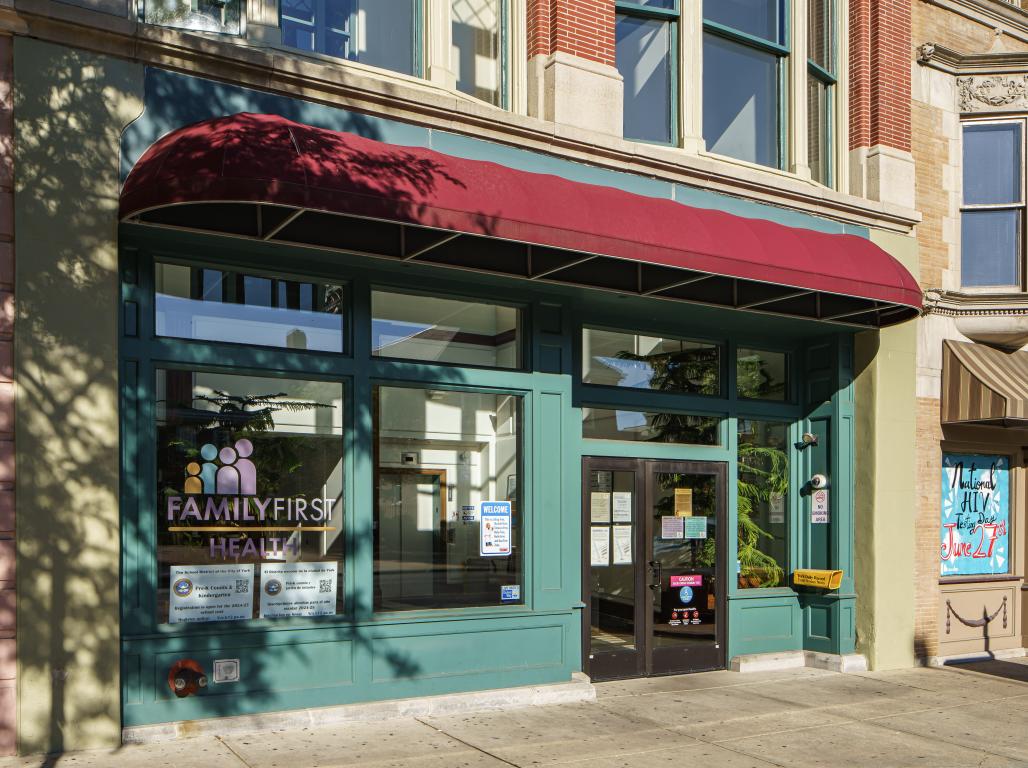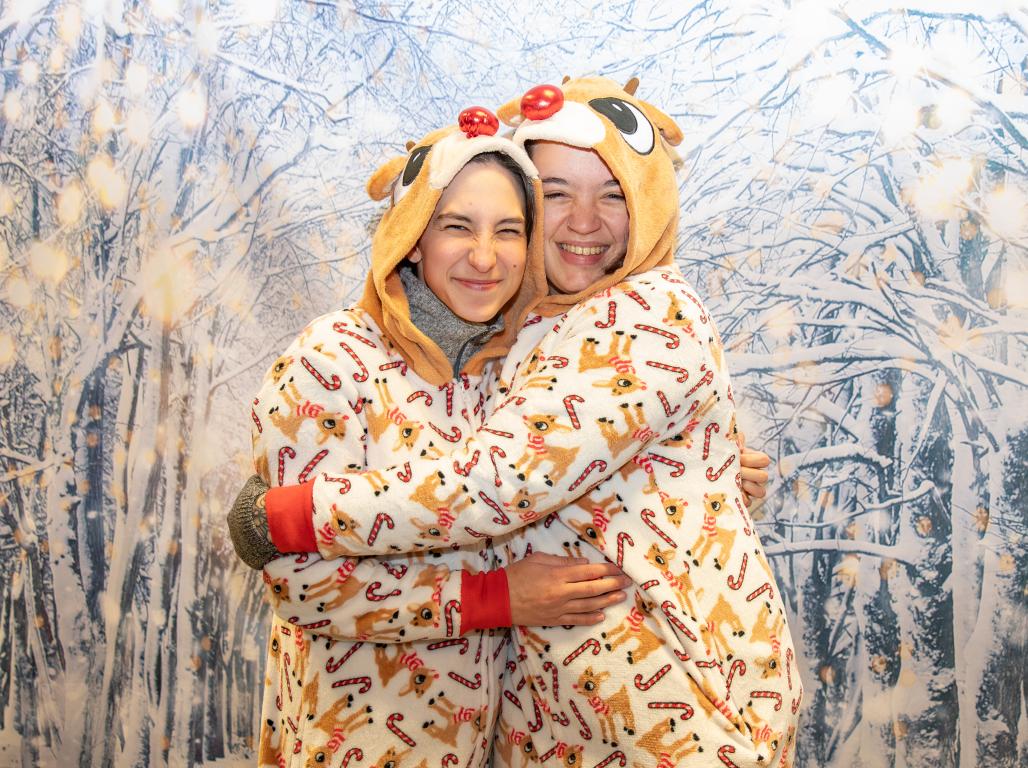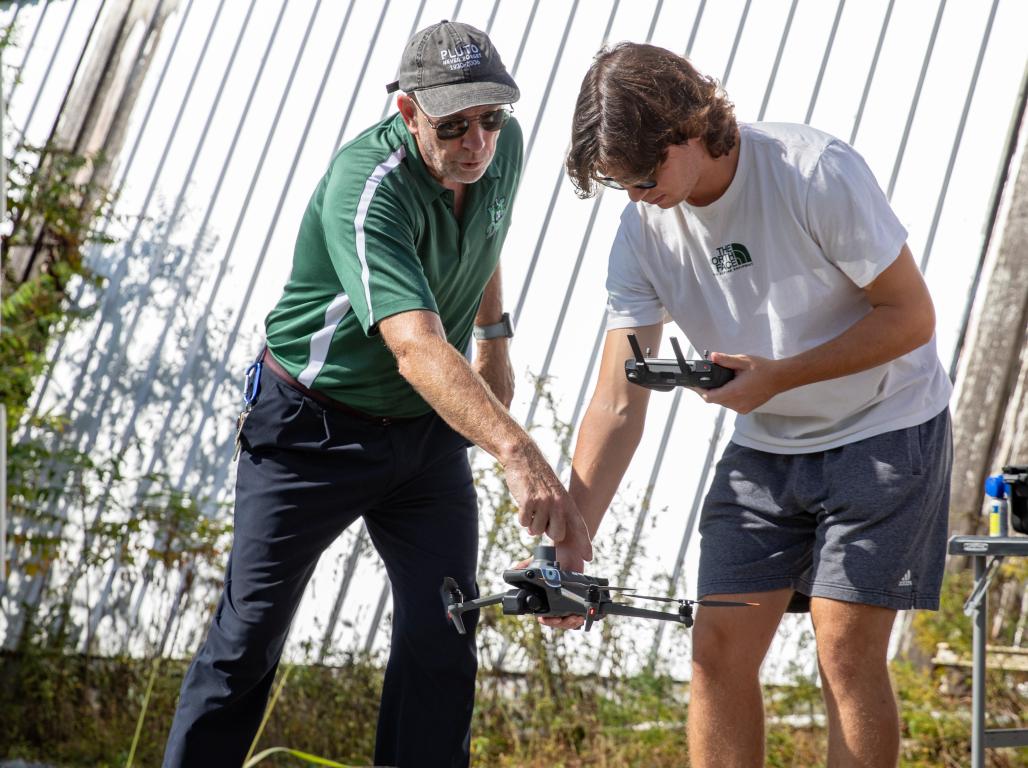Dr. Pamela Gunter-Smith Leaves a Future-focused Legacy at York College

The President of 10 years created a student-centric, community-minded culture that will serve the institution well, whatever the future might hold.
Dr. Pamela Gunter-Smith has been a trailblazer and an inspiration during her decade as President of York College of Pennsylvania. As she retires, her legacy of transformational leadership and community engagement will continue to carry the College forward.
The Students’ President
When Dr. Gunter-Smith began her tenure as President in 2013, students, faculty, and staff immediately noticed something different in her leadership style. Not only was she the first woman and person of color to serve as President, but she quickly became the students’ President, adopting the title of Dr. G-S, signaling how approachable she was. Students regularly found her and husband J. Lawrence (JL) Smith, fondly known as the “First Dude,” in the bleachers at a Spartan basketball game or cheering on the sidelines of the baseball field.
George Glatfelter, former Chair of the Board of Trustees, led the presidential search committee that chose Dr. Gunter-Smith. As the panel narrowed the field of candidates, he began to consider what type of person not only had the necessary credentials but could take York College to the next level.
“I began to think deeper and came to the realization that the people I’ve known in that role at different colleges throughout my life, the one thing that differentiated those who really made a difference, they were student-centric,” he says. “That is the key differentiator between Pamela and all the other candidates.”
Strategic Plan for a Greater York College
Dr. Gunter-Smith’s passion for students extended well beyond the athletic fields. She wanted every student to leave York College career-ready, with a professional network in place. At the same time, she wanted the College to have an overarching vision and direction.
“When I came to York,” she says, “one of the things that I found was that there was the President’s plan, and then each department or unit set their own individual plan.” She thought it important that first, the College have an overall direction that everyone could look to, and second, that every unit on campus have ownership of the plan. She didn’t want it to be hers alone; she envisioned a strategic plan for the College as a whole.
She brought the offices and departments of the College together and set out to develop the 2016-2021 Strategic Plan for a Greater York College. It had five main goals: academic excellence, robust enrollment, distinctiveness and alumni engagement, engagement with communities and practices of higher education, and financial support and sustainability.
Laura Wand has served on the Board of Trustees for 11 years and now is the first female Chair of the Board. She met Dr. Gunter-Smith as a member of the presidential search committee.
“She deeply understands the institution. She knows where it needs to go,” says Wand. “And it’s been evident if you look back over the 10 years she’s been with us that she has taken us forward and done that thing that all good presidents of institutions should do, which is to make that diploma more valuable than it was previously.”
Expanding the Center for Community Engagement
Through the development of the Strategic Plan and Dr. Gunter-Smith’s student-centric approach, the College embraced a greater focus on experiential learning. Dr. Gunter-Smith saw this method of education as important not just for students in Engineering and Nursing, where it was employed, but for students in every major. One avenue to expand that type of learning was the Center for Community Engagement (CCE).
“One of the things in the first Strategic Plan that I’m particularly proud of is the Center for Community Engagement,” says Dr. Gunter-Smith.
The CCE existed before Dr. Gunter-Smith came to York College, but under her leadership its reach greatly extended. That expansion of the CCE brought together her passion for experiential learning and a desire to more strongly connect the College with the York community. Through the CCE, York College students could learn about service, civic engagement, and social justice. The CCE offers a variety of programs and initiatives to help students connect with the community and make a positive impact.
While the CCE provided opportunities to improve the community, that wasn’t Dr. Gunter-Smith’s main goal. The CCE offered a way for York City and York County to become a living laboratory where York College students could get hands-on experiential learning while making a difference.
Dr. Dominic DelliCarpini, Dean of the CCE, also was a member of the presidential search committee. When he met Dr. Gunter-Smith, he saw her passion for creating a student-focused institution that could make an impact on the local community and for enhancing the role of the CCE.
“What the President brought to this is an understanding that the need extended much further,” Dr. DelliCarpini says, “and that it was great for our students’ education to be able to think beyond what we did right on our main campus and getting them out into a place like York City and to the county more generally.”
Through the leadership of Dr. Gunter-Smith and Dr. DelliCarpini, the CCE mission expanded to Marketview Arts, a York City working gallery that opened the door for visual arts students to gain hands-on experience in the field.
Another outgrowth of the CCE was the Glatfelter Institute for Public Policy, which moved the College toward becoming a think tank and a research center for the community. A Master’s degree program in Public Policy Administration took shape as well.
Experiential learning across disciplines
Experiential learning opportunities weren’t limited to the CCE. Dr. Gunter-Smith envisioned a York College where every program offered the chance for project-based learning to teams of students from across disciplines.
“We’re trying to expand co-ops, and we’re also trying to expand internships so that students have that experience when they leave,” Dr. Gunter-Smith says.
Hospitality Management students worked on projects for the renovation of The Yorktowne Hotel. Recreation Leadership and Sport Management majors engaged with students from York City schools to offer mentoring and leadership development. Art students held gallery openings at Marketview Arts. Communication majors helped promote and document a music festival. The College’s Honors Community created study-abroad programming. Across every school at the College, experiential learning opportunities blossomed.
Beyond such project-based learning, Dr. Gunter-Smith readily listened to students and worked with them to make their visions a reality. Brothers and Biology majors Brandon and Brody Cain ’23 approached Dr. Gunter-Smith with the idea of bringing an Emergency Medical Services program to campus. The twins had served on their hometown EMS squad and saw the need for faster on-campus medical care.
Dr. Gunter-Smith not only encouraged the idea, she funded training for every student interested in becoming an Emergency Medical Technician who was willing to serve on the campus EMS squad.
Hands-on infrastructure
While Dr. Gunter-Smith is about to begin the next stage of her journey, parts of her legacy are still taking shape. Early in her tenure she began working on a vision for the Graham Center for Collaborative Innovation (GCCI), an outgrowth of the first Strategic Plan that became a primary focus of Strategic Plan 2.0 (SP2.0), which activated in 2022.
The GCCI, which consists of three parts, aims to create project-based interdisciplinary learning initiatives, connect with the business community, and provide innovative solutions as it incorporates some of the elements of the first Strategic Plan.
The first part of the GCCI is the Knowledge Park, which will offer space for area businesses and nonprofits to collaborate with faculty, students, and each other.
“I’m very proud of what the Knowledge Park is going to do for our students in terms of launching their careers,” says Dr. Gunter-Smith. “I think it’s going to move us to the next level as an institution.”
Dr. DelliCarpini, who was instrumental in launching the GCCI, agrees.
“The Center for Collaborative Innovation and the Knowledge Park that it will house are in many ways a way to be able to acknowledge that this community is better because of the intellectual capital that the College brings to this work,” he says.
The Honors Community, the second element of the GCCI, comprises the Honors Community and its scholarship programs, while the third part, the Center for Faculty Excellence, supports faculty members as they seek collaboration and work across disciplines.
Through these three components, Dr. Gunter-Smith hopes the GCCI will become a model for other institutions.
“I think the Graham Center for Collaborative Innovation and the Center for Community Engagement together will serve a similar purpose for the College, and that is to continue our march toward being the premiere institution for experiential learning in this region and perhaps across the country,” Dr. DelliCarpini says.
EVOLVE toward the future
The GCCI was able to move forward in part because of the EVOLVE fundraising campaign. The effort initiated by Dr. Gunter-Smith amassed $20 million for the GCCI, which will support the Center for Community Engagement, the Doris and Bernard Gordon Center for Jewish Student Life, the Knowledge Park, the York College Community Opportunity Scholarship Program, and the York College Urban Collaborative.
The EVOLVE campaign was the College’s first comprehensive fundraising effort, with a goal of $70 million. The campaign focused on seven priorities: the GCCI, the York College Fund, a new Spartan Commons, scholarships, Spartan Athletics, academic excellence and innovation, and York Country Day School, an affiliate of the College.
York College Vice President of Development Troy Miller headed the EVOLVE campaign. It launched virtually in 2020 amid the coronavirus pandemic, with an initial goal of $50 million. The goal was increased to $70 million, but the campaign surpassed that amount and raised more than $90 million. Dr. Gunter-Smith wrapped up the EVOLVE campaign on Dec. 31, 2022, six months early, and shifted her focus to stewarding the funds.
“Through her leadership, we had over 10,000 donors to the campaign, and over 10% of our entire alumni base gave to the campaign,” Miller says.
An insightful reorganization
Apart from funding infrastructure initiatives, Dr. G-S set out to ensure that the College was organized in a way that advanced its more than 50 baccalaureate majors. Under her watch in 2020, the College reorganized its 11 departments into five schools: the Graham School of Business; the School of Nursing and Health Professions (now known as the Dr. Donald E. and Lois J. Myers School of Nursing and Health Professions); the Kinsley School of Engineering, Sciences and Technology; the School of Behavioral Sciences and Education; and the School of the Arts, Communication and Global Studies.
“The reason to have the five schools was actually to bring the disciplines together,” Dr. Gunter-Smith says. Decisions such as moving the Hospitality Management and Sport Management programs under the Graham School of Business and including Behavioral Sciences and Education in the same school helped students broaden their interdisciplinary focus and made them more well-rounded.
“It’s really going to enable us to grow academically and programmatically in a different space,” Dr. Gunter-Smith says.
Since reorganizing, the College has added, among other majors, a Civil Engineering program and an Environmental Horticulture program, with infrastructure in the works for both. Dr. Stacey Dammann was named the first Dean of the School of Behavioral Sciences and Education. The new structure offered opportunities for synergy between the majors and brought graduate programs together under a Director of Graduate and Professional Programs.
“I think that we came up with a really good plan for the five-school structure,” Dr. Dammann says. “It really moved the institution more toward a university structure, if you will. That brings some really great opportunities that I think the faculty who had been here for a while hadn’t experienced.”
Overcoming the odds
Near the end of her tenure, Dr. Gunter-Smith faced a challenge never before confronted by a York College president: a global pandemic.
Her combined background in science and academia made Dr. Gunter-Smith the right leader at the right time. She acted quickly to set up systems of remote learning.
“We were early in the game for getting cameras in our classrooms to be able to offer Zoom instruction for students who could not be here in person, as well as classroom opportunities socially distanced and with every safeguard that we could come up with,” says Dr. Dammann.
The controversial decision to reopen the College to in-person classes in the fall of 2020 proved a benefit in the end, getting the College back on track and providing an outlet for students who felt they were stuck in limbo. As part of that decision, Dr. Gunter-Smith oversaw an increased focus on student mental health, wellness, and well-being initiatives, ushering in services such as TimelyCare, a virtual health and well-being offering, and supporting the campus Counseling Center.
Beyond the campus
Despite those challenges and feeling as if she had lost two years of her presidency to the pandemic, Dr. Gunter-Smith continued to expand her focus beyond York College to have an impact on the York community.
“One of the things that I wanted when I came here as President and that attracted me to this position was the ability to be in a place that mattered, one that the College mattered to the community and the community mattered to the College,” says Dr. Gunter-Smith.
Dr. DelliCarpini saw that passion in Dr. Gunter-Smith when he met her during the interview process.
“I remember from the start how impressed I was with the clarity she was bringing to what she wanted to do as President of the College,” he says. “She understood that this was a community much in need of the anchor institution that York College could be.”
Kim Bracey, CEO of YWCA York and a member of the York College Board of Trustees, was the Mayor of York City when Dr. Gunter-Smith became President. She recalls sitting down with her over dinner at The Yorktowne Hotel as Dr. Gunter-Smith debated whether to take the position at the College. As the first person of color to serve as York City Mayor, Bracey believed that she and Dr. Gunter-Smith shared a certain grit.
“She was methodical, every step that she took, and knew what she wanted to get done at York College and how she really wanted to bridge the gap between the city, the community, and the College,” says Bracey. Over the course of a decade, Bracey watched Dr. Gunter-Smith bring that vision to life. She was at the table with community leaders, helping guide the conversations to build not just a greater York College, but a greater York.
Looking back at the four presidents of York College, Troy Miller sees a natural progression from great to greater.
“They all brought something special to this institution,” he says. “President (Ray A.) Miller moved us from a two-year school to a four-year school. President (Robert V.) Iosue developed the financial model that we still use. President (George) Waldner made our campus the campus it is today. But Pamela, what she did is she made this York’s college. And I think if people talk about her legacy in the future, above and beyond everything else she’s done, she brought York to the College and she brought the College to York.”
“She leaves the College stronger than she found it,” Wand says. “We have new majors. We have schools that have been set up to focus on expanding the majors that are valuable to both students and to the communities. We are a bit more open as a community, as an institution. We have found our footing on who we best serve. We have found our mission.
“She leaves us with a vision for the next five years with our Strategic Plan 2.0, and she leaves us with a highly successful, first-ever comprehensive campaign, the EVOLVE campaign. So not only do we have a blueprint for what we need to do going forward, we have the resources to make it happen.”




